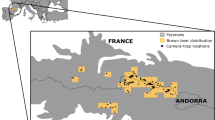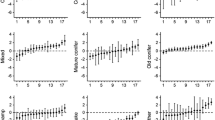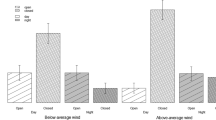Abstract
Prey usually adjust anti-predator behavior to subtle variations in perceived risk. However, it is not clear whether adult large carnivores that are virtually free of natural predation adjust their behavior to subtle variations in human-derived risk, even when living in human-dominated landscapes. As a model, we studied resting-site selection by a large carnivore, the brown bear (Ursus arctos), under different spatial and temporal levels of human activity. We quantified horizontal and canopy cover at 440 bear beds and 439 random sites at different distances from human settlements, seasons, and times of the day. We hypothesized that beds would be more concealed than random sites and that beds would be more concealed in relation to human-derived risk. Although human densities in Scandinavia are the lowest within bear ranges in Western Europe, we found an effect of human activity; bears chose beds with higher horizontal and canopy cover during the day (0700–1900 hours), especially when resting closer to human settlements, than at night (2200–0600 hours). In summer/fall (the berry season), with more intensive and dispersed human activity, including hunting, bears rested further from human settlements during the day than in spring (pre-berry season). Additionally, day beds in the summer/fall were the most concealed. Large carnivores often avoid humans at a landscape scale, but total avoidance in human-dominated areas is not possible. Apparently, bears adjust their behavior to avoid human encounters, which resembles the way prey avoid their predators. Bears responded to fine-scale variations in human-derived risk, both on a seasonal and a daily basis.

Similar content being viewed by others
Literature cited
Akaike H (1974) A new look at the statistical model identification. Trans Automat Contr 19:716–723
Arnemo J, Fahlman Å (2007) Biomedical protocols for free-ranging brown bears, gray wolves, wolverines and lynx. Norwegian School of Veterinary Science, Tromsø
Arnemo JM, Ahlqvist P, Andersen R, Berntsen F, Ericsson G, Odden J, Brunberg S, Segerström P, Swenson JE (2006) Risk of anesthetic mortality in large free-ranging mammals: experiences from Scandinavia. Wildl Biol 12:109–113
Bellemain E, Swenson JE, Tallmon O, Brunberg S, Taberlet P (2005) Estimating population size of elusive animals with DNA from hunter-collected feces: four methods for brown bears. Conserv Biol 19:150–161
Bischof R, Swenson JE, Yoccoz NG, Mysterud A, Gimenez O (2009) The magnitude and selectivity of natural and multiple anthropogenic mortality causes in hunted brown bears. J Anim Ecol 78:656–665
Blanc R, Guillemain M, Mouronval J-B, Desmonts D, Fritz H (2006) Effects of non-consumptive leisure disturbance to wildlife. Rev Ecol (Terre Vie) 61:117–133
Blumstein DT (2006) Developing an evolutionary ecology of fear: how life history and natural history traits affect disturbance tolerance in birds. Anim Behav 71:389–399
Blumstein DT (2007) The evolution, function, and meaning of marmot alarm communication. Adv Study Behav 37:371–400
Bongi P, Ciuti S, Grignolio S, Del Frate M, Simi S, Gandelli D, Apollonio M (2008) Anti-predator behaviour, space use and habitat selection in female roe deer during the fawning season in a wolf area. J Zool 276:242–251
Boydston E, Kapheim K, Watts H, Szykman M, Holekamp K (2003) Altered behaviour in spotted hyenas associated with increased human activity. Anim Conserv 6:207–219
Brown JS, Kotler BP (2004) Hazardous duty pay and the foraging cost of predation. Ecol Lett 7:999–1014
Conover MR (2007) Predator–prey dynamics: the role of olfaction. CRC Press, Boca Raton
Cooper WE (2008) Visual monitoring of predators: occurrence, cost and benefit from escape. Anim Behav 76:1365–1372
Cooper WE, Frederick WG (2007) Optimal flight initiation distance. J Theor Biol 244:59–67
Dahle B, Swenson JE (2003) Seasonal range size in relation to reproductive strategies in brown bears Ursus arctos. J Anim Ecol 72:660–667
Elfström M, Swenson JE, Ball JP (2008) Selection of denning habitats by Scandinavian brown bears Ursus arctos. Wildl Biol 14:176–187
Farley SD, Robbins CT (1995) Lactation, hibernation, and mass dynamics of American black bears and grizzly bears. Can J Zool 73:2216–2222
Fernández N, Delibes M, Palomares F (2006) Landscape evaluation in conservation: molecular sampling and habitat modelling for the Iberian lynx. Ecol Appl 16:1037–1049
Frid A, Dill LM (2002) Human-caused disturbance stimuli as a form of predation risk. Conserv Ecol 6:11
Friebe A, Swenson JE, Sandegren F (2001) Denning chronology of female brown bears in central Sweden. Ursus 12:37–46
Gibeau ML, Clevenger AP, Herrero S, Wierzchowski J (2002) Grizzly bear response to human development and activities in the Bow River watershed, Alberta. Can Biol Conserv 103:227–236
Heard DC (1992) The effect of wolf predation and snow cover on musk-ox group size. Am Nat 139:190–204
Heard DC, Ciarnello LM, Seip DR (2008) Grizzly bear behavior and global positioning system collar fix rates. J Wildl Manag 72:596–602
Kaczensky P, Huber D, Knauer F, Roth H, Wagner A, Kusak J (2006) Activity patterns of brown bears (Ursus arctos) in Slovenia and Croatia. J Zool 269:474–485
Karlsson C, Westman SE (1991) Skogsuppskattning, skogsinventering, 2nd edn. Sollefteå, Sweden (in Swedish)
Kotler BP, Brown J, Hasson O (1991) Factors affecting gerbil foraging behavior and rates of owl predation. Ecology 72:2249–2260
Lemmon PE (1956) A spherical densiometer for estimating forest overstory density. For Sci 2:314–320
Lima SL, Dill LM (1990) Behavioural decisions made under the risk of predation: a review and prospectus. Can J Zool 68:619–640
Link WA, Barker RJ (2006) Model weights and the foundations of multimodel inference. Ecology 87:2626–2635
Lyons AL, Gaines WL, Servheen C (2003) Black bear resource selection in the northeast Cascades, Washington. Biol Conserv 113:55–62
Mace RD, Waller JS, Manley TL, Lyon LJ, Zuuring H (1996) Relationships among grizzly bears, roads and habitat in the Swan Mountains Montana. J Appl Ecol 33:1395–1404
Manly BFJ, McDonald LL, Thomas DL, McDonald TL, Erickson WP (2002) Resource selection by animals. Statistical design and analysis for field studies, 2nd edn. Kluwer, Dordrecht, p 240
Martín J, López P (2004) Iberian rock lizards (Lacerta monticola) assess short-term changes in predation risk level when deciding refuge use. J Comp Psychol 118:280–286
Mattson DJ, Knight RR, Blanchard BM (1992) Cannibalism and predation on black bears by grizzly bears in the yellowstone ecosystem, 1975–1990. J Mammal 73:422–425
Mattson DJ, Herrero S, Wright RG, Pease CM (1996) Science and management of Rocky Mountain grizzly bears. Conserv Biol 10:1013–1025
May R, van Dijk J, Wabakken P, Swenson JE, Linnell JDC, Zimmermann B, Odden J, Pedersen HC, Andersen R, Landa A (2008) Habitat differentiation within the large-carnivore community of Norway’s multiple-use landscapes. J Appl Ecol 45:1382–1391
Moe TF, Kindberg J, Jansson I, Swenson JE (2007) Importance of diel behaviour when studying habitat selection: examples from female Scandinavian brown bears (Ursus arctos). Can J Zool 85:518–525
Moreno S, Villafuerte R, Delibes M (1996) Cover is safe during the day but dangerous at night: the use of vegetation by European wild rabbits. Can J Zool 9:1656–1660
Morris DW, Kotler BP, Brown JS, Sundararaj V, Ale SB (2009) Behavioral indicators for conserving mammal diversity. Ann NY Acad Sci 1162:334–356
Mueller C, Herrero S, Gibeau ML (2004) Distribution of subadult grizzly bears in relation to human development in the Bow River Watershed, Alberta. Ursus 15:35–47
Munro RH, Nielsen SE, Price MH, Stenhouse GB, Boyce MS (2006) Seasonal and diel patterns of grizzly bear diet and activity in west-central Alberta. J Mammal 87:1112–1121
Mysterud A (1996) Bed-site selection by adult roe deer Capreolus capreolus in southern Norway during summer. Wildl Biol 2:101–106
Mysterud A, Østbye E (1999) Cover as a habitat element for temperate ungulates: effects on habitat selection and demography. Wildl Soc Bull 27:385–394
Naves J, Wiegand T, Revilla E, Delibes M (2003) Endangered species constrained by natural and human factors: the case of brown bears in northern Spain. Conserv Biol 17:1276–1289
Nellemann C, Støen O-G, Kindberg J, Swenson JE, Vistnes I, Ericsson G, Katajisto J, Kaltenborne BP, Martin J, Ordiz A (2007) Terrain use by an expanding brown bear population in relation to age, recreational resorts and human settlements. Biol Conserv 138:157–165
Noss RF, Quigley HB, Hornocker MG, Merrill T, Paquet PC (1996) Conservation biology and carnivore conservation in the Rocky Mountains. Conserv Biol 10:949–963
Ordiz A, Støen O-G, Langebro L, Brunberg S, Swenson JE (2009) A practical method for measuring horizontal cover. Ursus 20:109–113
Preatoni D, Mustoni A, Martinoli E, Carlini B, Chiarenzi S, Chiozzini S, Van Dongen LA, Wauters A, Tosi G (2005) Conservation of brown bear in the Alps: space use and settlement behavior of reintroduced bears. Acta Oecol 28:189–197
R Development Core Team (2009). R: a language and environment for statistical computing. R Foundation for Statistical Computing, Vienna, Austria. ISBN 3-900051-07-0. http://www.R-project.org
Revilla E, Palomares F, Fernández N (2001) Characteristics, location and selection of diurnal resting dens by Eurasian badgers (Meles meles) in a low density area. J Zool 255:291–299
Rode KD, Farley SD, Robbins CT (2006a) Behavioral responses of brown bears mediate nutritional effects of experimentally introduced tourism. Biol Conserv 133:70–80
Rode KD, Robbins CT, Farley SD (2006b) Sexual dimorphism, reproductive strategy, and human activities determine resource use by brown bears. Ecology 87:2636–2646
Rodgers AR, Rempel RS, Abraham KF (1996) A GPS-based telemetry system. Wildl Soc Bull 24:559–566
Semeniuk CAD, Dill LM (2005) Cost/benefit analysis of group and solitary resting in the cowtail stingray, Pastinachus sephen. Behav Ecol 16:417–426
Servheen C, Herrero H, Peyton B, IUCN/SSC Bear and Polar Bear Specialists Groups. (1999) Bears: Status survey and conservation action plan. IUCN, Switzerland
Sih A (1992) Prey uncertainty and the balancing of antipredator and feeding needs. Am Nat 139:1052–1069
Stankovich T, Blumstein DT (2005) Fear in animals: a meta-analysis and review of risk assessment. Proc R Soc Lond B 272:2627–2634
Statistics Sweden (2008) Statistical database. Population statistics, 2007. http://www.ssd.scb.se/databaser/makro/start.asp?lang=2
Stiner M (1999) Cave bear ecology and interactions with pleistocene humans. Ursus 11:41–58
Stoks R, McPeek MA, Mitchell JL (2003) Evolution of prey behavior in response to changes in predation regime: damselflies in fish and dragonfly lakes. Evolution 57:574–585
Sunde P, Stener SØ, Kvam T (1998) Tolerance to humans of resting lynxes Lynx lynx in a hunted population. Wildl Biol 4:177–183
Suring H, Farley S, Hilderbrand G, Goldstein M, Howlin S, Erickson W (2006) Patterns of landscape use by female brown bears on the Kenai Peninsula, Alaska. J Wildl Manag 70:1580–1587
Swenson JE, Wabakken P, Sandegren F, Bjärvall A, Franzén R, Söderberg A (1995) The near extinction and recovery of brown bears in Scandinavia in relation to the bear management policies of Norway and Sweden. Wildl Biol 1:11–25
Swenson JE, Gerstl N, Dahle B, Zedrosser A (2000) Action plan for the conservation of the brown bear (Ursus arctos) in Europe. Convention on the Conservation of European Wildlife and Natural Habitats (Bern Convention), Nature and Environment, No. 114
Swenson JE, Dahle B, Sandegren F (2001) Intraspecific predation in Scandinavian brown bears older than cubs-of-the-year. Ursus 12:81–92
Theuerkauf J, Rouys S, Jedrzejewski W (2003) Selection of den, rendezvous, and resting sites by wolves in the Bialowieza Forest, Poland. Can J Zool 81:163–167
Van Moorter B, Gaillard J-M, McLoughlin PD, Delorme D, Klein F, Boyce MS (2009) Maternal and individual effects in selection of bed sites and their consequences for fawn survival at different spatial scales. Oecologia 159:669–678
Vitousek PM, Ehrlich PR, Ehrlich AH, Matson PA (1986) Human appropriation of the products of photosynthesis. Bioscience 36:368–373
Woodroffe R (2000) Predators and people: using human densities to interpret declines of large carnivores. Anim Conserv 3:165–173
Woodroffe R, Ginsberg JR (1998) Edge effects and the extinction of populations inside protected areas. Science 280:2126–2128
Ydenberg RC, Dill LM (1986) The economics of fleeing from predators. Adv Study Behav 16:229–249
Acknowledgements
We appreciate the help provided in the field by volunteers and students of the Scandinavian Brown Bear Research Project, which is funded by the Swedish Environmental Protection Agency, Norwegian Directorate for Nature Management, Swedish Association for Hunting and Wildlife Management, WWF Sweden, Research Council of Norway, and the program “Adaptive management of fish and wildlife populations”. AO was funded by Fundación Oso de Asturias, funds provided by Hunosa and Sato. The manuscript greatly benefited from comments and advice by M. Basille, R. Bischof, J. Naves, S. Sæbø, G. Sonerud, P. Wegge, A. Zedrosser, and an anonymous reviewer.
Author information
Authors and Affiliations
Corresponding author
Additional information
Communicated by Jean-Michel Gaillard.
Electronic supplementary material
Below is the link to the electronic supplementary material.
Rights and permissions
About this article
Cite this article
Ordiz, A., Støen, OG., Delibes, M. et al. Predators or prey? Spatio-temporal discrimination of human-derived risk by brown bears. Oecologia 166, 59–67 (2011). https://doi.org/10.1007/s00442-011-1920-5
Received:
Accepted:
Published:
Issue Date:
DOI: https://doi.org/10.1007/s00442-011-1920-5




